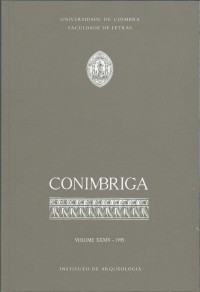Please use this identifier to cite or link to this item:
https://hdl.handle.net/10316.2/45461| Title: | Barragens romanas do distrito de Castelo Branco e Barragem de Alferrarede | Authors: | Quíntela, António de Carvalho Cardoso, João Luís Mascarenhas, José Manuel |
Issue Date: | 1995 | Publisher: | Imprensa da Universidade de Coimbra | Abstract: | Descrevem-se os vestígios das barragens do distrito de Castelo Branco
atribuídas ao período romano e procura-se reconstituir as suas características iniciais. Caracteriza-se ainda a barragem de Alferrarede, pós-romana, em bom estado de conservação, de duplo muro e aterro intermédio, e apresentam-se dados retirados da bibliografia relativos à "Presa de Penamacor", que sofreu um rombo no primeiro quartel do século XVI e da qual não há vestígios.
Das oito barragens atribuídas ao período romano, duas são de alvenaria e seis de terra. Estas últimas parecem não ter sido dotadas de descarregadores de superfície (nem de órgãos fixos para assegurar a utilização da água). A conservação de vestígios dos aterros poderá dever- -se à existência de brechas que asseguram a passagem da água sem galgamento.
Algumas das barragens de terra eram estruturas importantes, que envolveram grandes movimentos de terra e a utilização de boas técnicas de compactação como atesta a caracterização geotècnica. As maiores barragens são a da Egitânia e da Lameira com alturas de 11 e 9 m e volumes de aterro de 12 000 e 16 000 m3, respectivamente. As barragens de terra estudadas assumem, assim, grande importância no Mundo Romano em face da escassez de estruturas comparáveis, exclusivamente de terra.
A atribuição das barragens ao período romano apoia-se nos seguintes factos:
- vestígios romanos nas imediações de cinco das barragens;
- analogias entre elas relativamente aos tipos construtivos;
- referência à barragem da Orca em documento de 1505;
- história da ocupação da região no período pós-romano;
- enquadramento histórico da construção de barragens medievais na Europa.
A finalidade de grande parte das barragens deve ter sido o apoio à mineração, visto verificar-se para cada caso, pelo menos, uma das seguintes situações:
- inexistência de villae a jusante;
- desconhecimento de vestígios de canais de adução entre as barragens e os habitats romanos a jusante, quando existem;
- recurso verificado a nascentes para a alimentação das villae nas proximidades das barragens (ou possibilidade do recurso a nascentes ou poços);
- inexistência a jusante de solos propícios à rega.
A ocupação romana da região e, particularmente, a actividade mineira são documentadas com base na bibliografia, sendo referenciados os achados de numerosos tesouros (joias e moedas) que atestam acumulação de riqueza, em resultado daquela actividade mineira. The dams vestiges in the district of Castelo Branco, attributed by the authors to the Romans, are described and the original characteristics of those dams are reconstituted. Two post-Roman dams, probably built in sixteenth century, are also described: - the Penamacor masonry dam, from which there are no vestiges, whose notice results only from bibliography; - the 13 m high Alferrarede dam, with two masonry walls and an earthfill core, which remains in a fairly good condition. From the eight dams atributed to the Romans, two were built in masonry and six in earthfill. The earthfill dams do not seem to have been provided with spillways and outlets. The vestiges of each of these dams consist of two earthfill reaches separated by a gap, which, nowadays, allows the water to pass. Some of those earth dams were important structures which implied the movement of large amount of earthfill and the use of adequate compactation technics, as shown by the geotechnical charaterization. The most important dams are those of Egitania and Lameira, with heights of 11 and 9 m and an earthfill volume of 12000 and 16000m3, respectively. The earth dams studied in this work were of great importance within the Roman World, considering the scarcity of comparable earth structures (without a masonry wall). The dams were attributed to the Roman period in the basis of the following facts: - existence of Roman vestiges in the neighbourhood of five dams; - dam construction types analogies; - reference to Orca dam in a document of the year 1505; - history of the country occupation in post-Roman period; - history of dam construction in Europe. The purpose of the most of studied dams was, very probably, the water supply to gold mining, because, at least, one of the following situations occurs for each dam: - non-existence of villae downstream of the dams; - absence of connecting channels vestiges between the dams and the roman habitats downstream, whenever existent; - non-existence of appropriated soils to irrigation, downstream of the dams. - existence of springs that were surely used to supply water to villae, located near the dams; the use of nearby springs and wells was also possible in other sites. The Roman occupation of the country and namely the gold mining activity are documented by the bibliography and the discovery of many treasures (jewels and coins) proves the accumulation of wealth as result of gold mining activity. |
URI: | https://hdl.handle.net/10316.2/45461 | ISSN: | 0084-9189 1647-8657 (PDF) |
DOI: | 10.14195/1647-8657_34_3 | Rights: | open access |
| Appears in Collections: | Conimbriga |
Files in This Item:
| File | Description | Size | Format | |
|---|---|---|---|---|
| barragens_romanas_do_distrito_de_castelo_branco.pdf | 12.14 MB | Adobe PDF |  |
Items in DSpace are protected by copyright, with all rights reserved, unless otherwise indicated.
